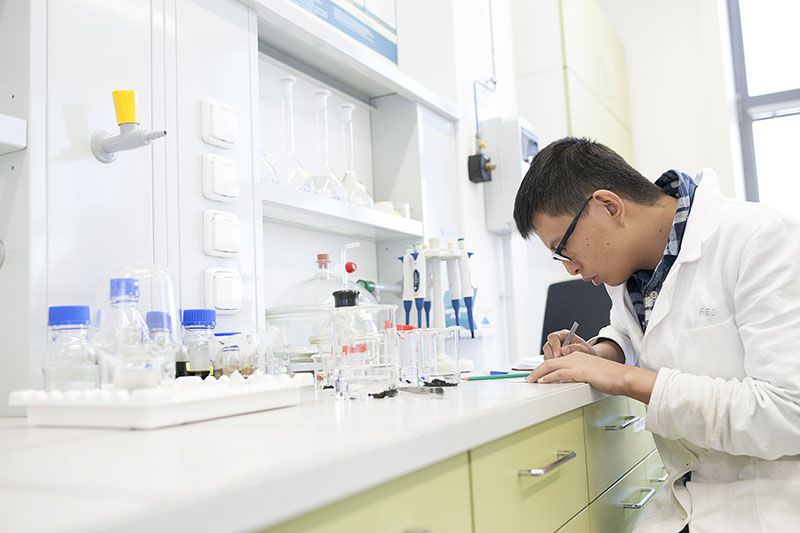The design of energy storage devices at the Tomas Bata University (TBU) in Zlín, Czechia is carried out within the University Institute centres Centre for Technology Transfer and Centre of Polymer Systems. TBU has been actively developing energy storage devices in two main directions: supercapacitors and lithium-based batteries. However, we examine also other scientific questions with connection to preparation of magnetic nanoparticles and design of matrices for advanced bio composite systems, such as natural biocompatible and biodegradable polymers. Finally, we consider the clean energy transition going far beyond technology solutions and include life-cycle assessment and other socio-economic aspects into research.
Advanced batteries and supercapacitors technologies
Future of energy storage is represented of batteries and supercapacitors technologies. Thus, worldwide many efforts are perform to accomplish the transition toward decarbonisation and electrification. Our research group at UTB is involved in development distinct direction which cope with advanced technologies related to electrochemical storage of energy:
Development of new generation of rechargeable batteries with improved electrochemical features and new chemistries, such as all-solid state batteries or hybrid technology;
Advanced symmetric and asymmetric supercapacitors or hybridized structures based on 2D and 3D nanostructure which enhance energy density and stabilize charge transfer;
Optimization and engineering of fabrication technologies for development of flexible structures in organic and aqueous electrolytes.
Magnetic Hyperthermia and Polymer Memristors
Research in this area focuses on the preparation of materials for various applications of conductive, dielectric and magnetic materials, from electromagnetic shielding, selectively reflective surfaces and selectively permeable plate materials, to the materials intended for the hyperthermic treatment of cancer, which have already been patented.
The material design is mainly focused on the preparation of magnetic nanoparticles, possibly also on the application or modification of magnetic and other fillers (particles and short fibres) from commercial sources into composite materials with a polymer matrix. In the field of synthesis, the group also successfully works with polyaniline and similar conductive polymers. The combination of a magnetic inorganic core and an electrically conductive polymer shell creates a core-shell particle with significantly improved properties. The ability to convert the absorbed energy of an alternating magnetic field into heat is used in cases which require a heat source in volume; in the most demanding application it is hyperthermia. The mentioned materials are also used to produce conductive composites for electromagnetic shielding. Selective reflectivity is then achieved by the preparation of so-called metamaterials, where, in addition to the material composition, the geometry of the individual components of the composite contributes to the function. Flat structures with material patterning are prepared by material printing methods.
Sino-EU Joint Laboratory of New Energy Materials and Devices
The current clean energy transition forms the basis of the ongoing transformation of the global energy sector from fossil sources to renewable energy sources. In this context, many scientific questions arise, including the types and forms of stakeholder participation, ownership issues, financial implications and other socio-economic aspects.
The requirements for future energy systems need to be examined in the context of key trends such as decarbonisation, decentralization and digitization. In addition, it is increasingly important to respond flexibly to innovations in the renewable energy sector, energy price volatility, and subsequently consider environmental, economic and social impact assessments of energy materials, technologies and equipment.
Energy and Medical Composite Systems
The subject of interest of this research group is the study and preparation of matrices for advanced biocomposite systems as well as active/functional components that can be incorporated into these matrices. The matrices are mainly polymer gels made of synthetic and natural biocompatible and biodegradable polymers. A special case is the use of bacterial cellulose from the team´s own production in bioreactors. These gels are used, for instance, as cover wounds in medicine, in pervaporation processes and are also applied (in cooperation with the group of Composites with electrical and magnetic properties) as an electrolyte in supercapacitors. Mineralized gels serve as templates in bone replacement surgery. The carbonate-based filler is prepared directly in the structure of the gel matrix by the biomimetic mineralization method. As functional agents, synthetic polypeptoids and peptoid nanoplates, which have significant biological activity, are used.
Socio-economic Aspects of Energy
The current clean energy transition forms the basis of the ongoing transformation of the global energy sector from fossil sources to renewable energy sources. In this context, many scientific questions arise, including the types and forms of stakeholder participation, ownership issues, financial implications and other socio-economic aspects.
The requirements for future energy systems need to be examined in the context of key trends such as decarbonisation, decentralization and digitization. In addition, it is increasingly important to respond flexibly to innovations in the renewable energy sector, energy price volatility, and subsequently consider environmental, economic and social impact assessments of energy materials, technologies and equipment.
Collaborating Institutions
- Clemson University, Clemson, South Carolina, USA
- East China University of Science and Technology, Shanghai, China
- Polymer Institute, Slovak Academy of Sciences, Bratislava, Slovakia
- Sabanci University, Istanbul, Turkey
- Institute of Macromolecular Chemistry, AS CR, Prague
- Riga Technical University, Riga, Latvia
- Marmara University, Istanbul, Turkey
- Technion, Israel Institute of Technology, Haifa, Israel
- Pavol Jozef Šafárik University in Košice, Slovakia
- Karlsruher Institut für Technologie (KIT), Germany
- Institute of Experimental Physics, , Slovak Academy of Sciences, Bratislava, Slovakia
- Institute of Nuclear Sciences “VINCA” , Serbia
- Centre National de la Recherche Scientifique (CNRS), acting for IPCMS and France - Institut de Physique et Chimie des Matériaux de Strasbourg (IPCMS), Francie




